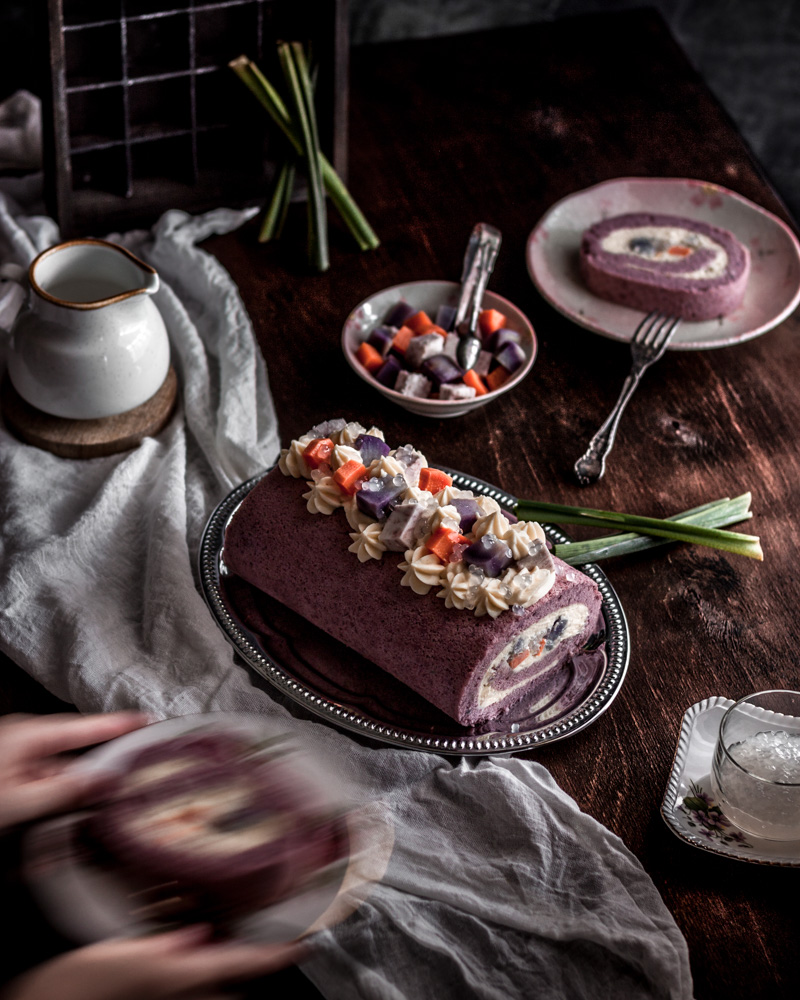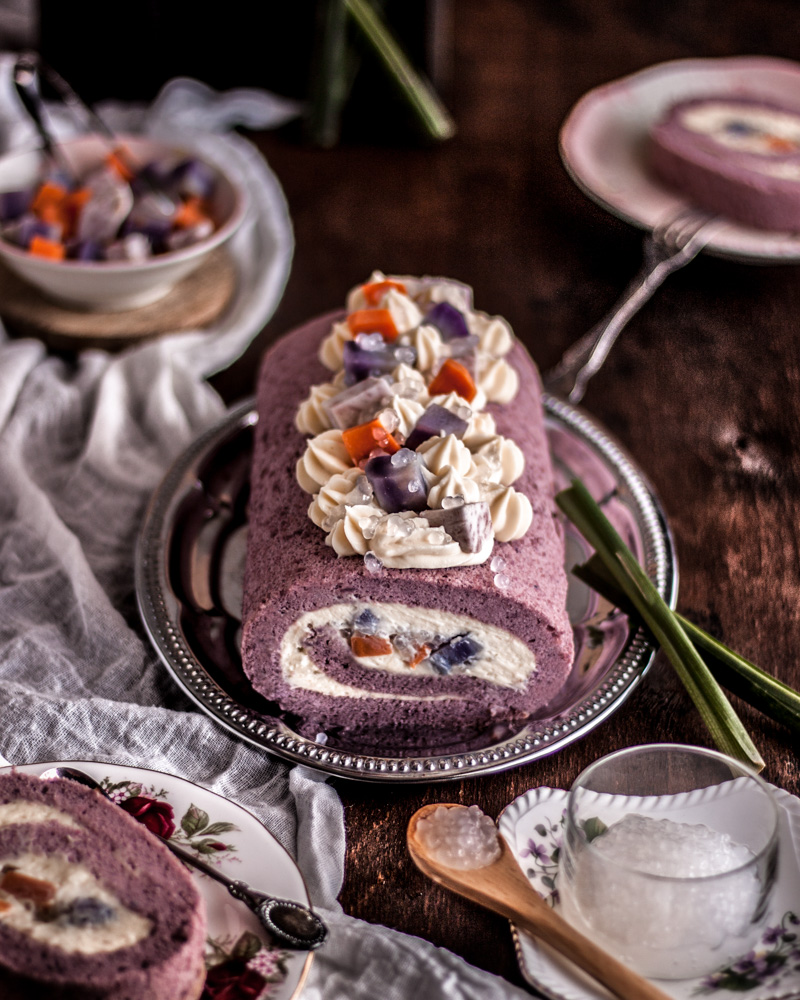
A taro and purple sweet potato cake rolled with pandan and coconut diplomat cream, sago, and extra pieces of sweet potato.
A more modern twist on a classic Malaysian dessert.
I had previously made a bubur cha cha layer cake for my birthday a few years ago, but never noted down the recipe, so I thought it was about time to revisit the idea.
Burbur cha cha is basically a dessert soup. It features a coconut and pandan liquid base, if you will, with pieces of sweet potato, taro, and a tapioca-based ‘jelly’. In this house, we generally just use sago. It’s so simple to make, I wouldn’t even bother creating a recipe for it. Steam pieces of sweet potato and taro. Boil water with pandan leaves. Add sugar and coconut milk to taste. Add cooked sago and the root veg. Boom. If you take only one thing from this post, it should be that you should try bubur cha cha.
We always love using purple-fleshed sweet potatoes (they’re white-skinned though!) because they’re usually sweeter than the orange-fleshed variety. However, if you can only find the orange and/or yellow type, just use those.
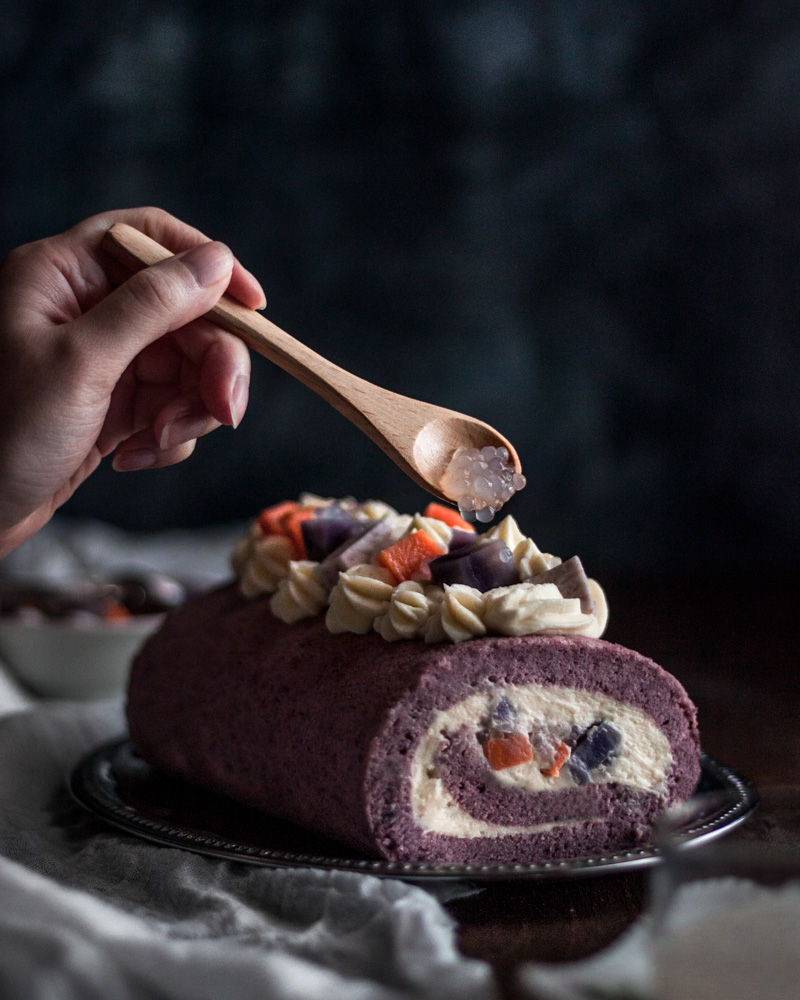
I decided to use a little food colouring in order to achieve that purple colour, but feel free to omit it. If your sweet potato is very strong in colour, you may be able to achieve a more natural, colour, though after baking it is likely to become a ‘muddier’, more grey purple.
If you cannot get purple sweet potato for the cake batter, feel free to use whatever sweet potato you can get OR feel free to omit it altogether and reduce the coconut milk to 30-40g (depending on the starchiness and dryness of your taro)
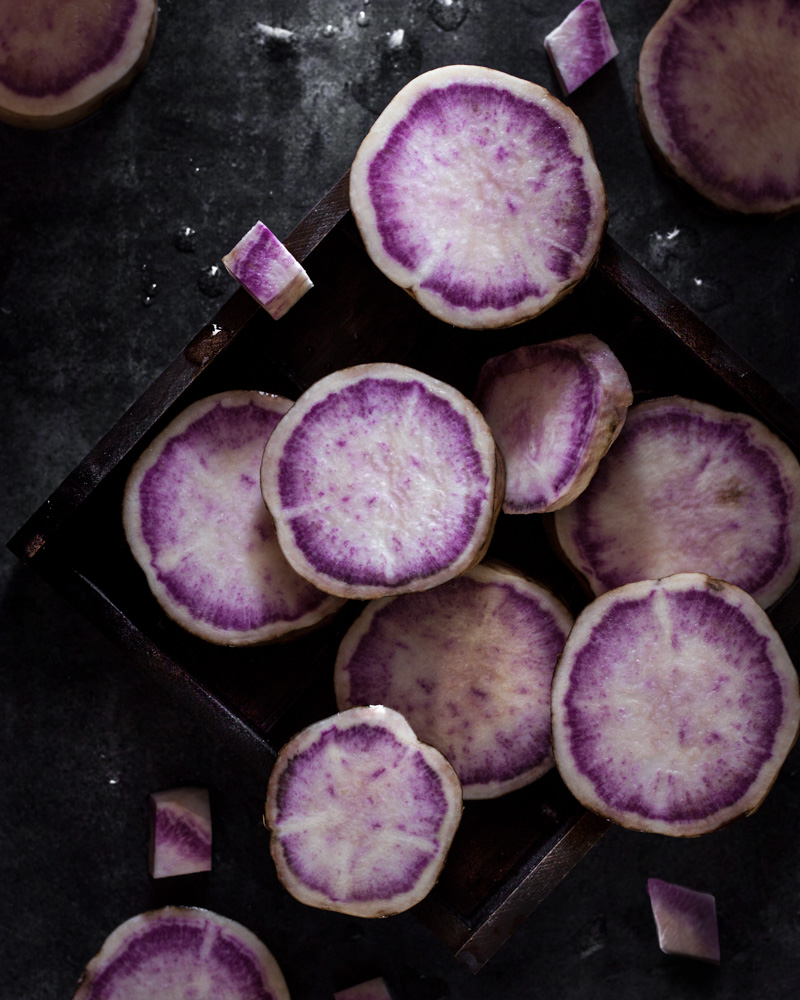
I’d actually advise against filling the cake as much as I did, as it makes rolling it up MUCH more difficult due to its weight (remember that it has pastry cream in it AND pieces of sweet potato, so the filling is much heavier than just whipped cream!) and thus makes it MUCH more prone to cracking.
Also to avoid cracking, don’t hesitate when rolling the cake up initially when hot – just go for it! the longer you hesitate and backtrack in the middle of rolling, the more likely to break as it is still warm and fragile.
To turn out the cake and prepare it for rolling, I always refer to this recipe from Just One Cookbook.

In saying that however, please don’t worry if it does crack or break – it will still be delicious! Similar to my previous post in which I talked about the fear of cheesecake ‘failure’, I used to never have the guts to make roll cakes/ swiss rolls as I was always scared of them cracking. I think we place too much emphasis on making ‘perfect’ baked goods that we forget that most of the time we make things because we enjoy the process of making and eating them. Unless you are claiming that you make ‘perfect’ goods, it doesn’t matter! Though I can’t deny that there is a thrill when seeing that something turned out ‘perfectly’ (lookin’ at u , macarons), we have to remind ourselves that that’s usually only 1/3 of the experience.
Funnily enough, when I bake something that I think looks pretty perfect, it always takes me longer to actually dig in since I don’t want to ‘ruin’ it. A bit silly, I know!
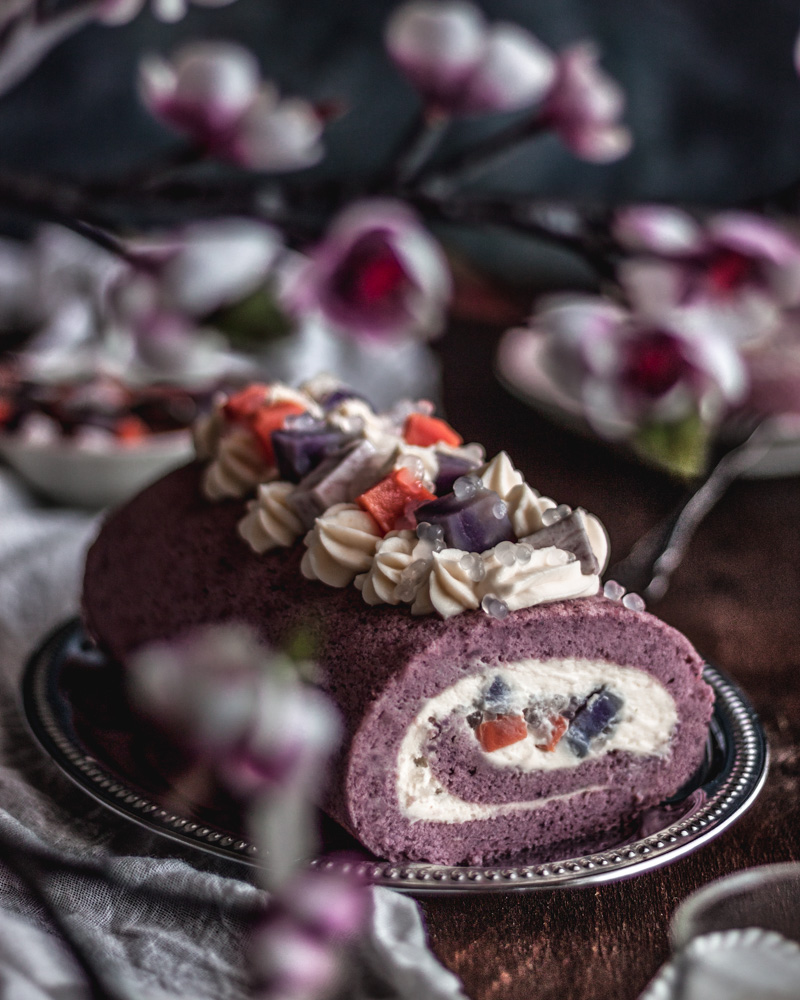
Recipe
For the coconut and pandan diplomat cream
INGREDIENTS:
- 245g (1c) coconut milk
- 4 half-length OR 2 full-length pandan leaves (approx.)
- 25g sugar
- 1 egg yolk*
- 1/2 egg*
- 15g corn flour
- 15g sugar
- 15g unsalted butter
- 250g thickened cream
*Alternatively, you could use 2 yolks and omit the 1/2 egg.
METHOD:
1. Pour the coconut milk into a pot. Scrunch then knot the pandan leaves and add them to the pot. Heat until the milk just starts to boil. Leave with the lid on for at least 1 hour to allow the pandan to infuse into the milk.
2. Remove the pandan leaves, making sure to squeeze all the liquid out of them into the milk.
3. In a separate bowl, mix together the 25g of sugar and corn flour until evenly combined. Whisk in the egg yolk and 1/2 egg until completely combined.
4. Add 15g of sugar into the milk and reheat until simmering. Slowly pour roughly 1/3 of the hot milk into the egg mixture a little at a time, making sure to vigorously whisk whilst doing so to ensure the egg does not cook.
Pour this mixture back into the pot and heat whilst constantly whisking until bubbling and thickened. Allow to bubble whilst whisking for about 1 minute, then remove from the heat.
5. Add the butter into the hot mixture and whisk until fully combined. Transfer to a heat-proof bowl or container to cool until just warm. Cover with clingwrap, ensuring the clingwrap is touching the surface of the pastry cream, and refrigerate until fully cool.
6. Whip the cream until stiff peaks form, then fold in roughly 250g of the pastry cream or enough to reach your own desired consistency. Set aside in the fridge.
For the taro and sweet potato cake
INGREDIENTS:
- 50g coconut milk
- 80g steamed taro
- 40g steamed purple-fleshed sweet potato
- 45g sugar
- 4 egg yolks
- 50g oil
- 70g plain flour
- 20g corn flour
- 45g sugar
- 4 egg whites
METHOD:
1. Preheat oven to 180°C and line a 38x25cm tray with baking paper, ensuring it goes up the sides of the tray too.
2. In a small bowl, mash the taro and sweet potato, gradually adding in coconut milk until the mixture is completely mashed and paste-like. Completely mix in the oil. Set aside.
3. In a large bowl, whisk the egg yolks and 45g of sugar until lighter in colour, thick, and ribbony. Add in the taro mixture and whisk until combined.
4. Sift in the plain flour and corn flour and gently whisk with a folding motion until completely incorporated. Set aside.
5. In a separate large bowl and using an electric hand mixer, beat the egg whites on a low or medium-low speed (I like to start off at 2-3 on my hand mixer) until all the whites are frothy. Slowly add in the last 45g of sugar, a little at a time, until soft peaks form whilst beating at a medium speed (around 4 on my hand mixer). Continue to beat on medium until just under stiff peaks.
6. Scoop 1/3 of the egg white mixture into the taro and flour mixture and fold to lighten up the mixture. Gently fold in the rest of the egg whites until no streaks remain.
7. Pour the batter into the prepared pan and spread it out evenly. bang the tray on the benchtop to get rid of any large air pockets. Bake for 12-15 minutes or until the cake bounces back when pressed and a skewer comes out clean.
8. Remove from the oven. You must do the following steps immediately:
– Place a large piece of baking paper over the top of the cake, and place a larger chopping board or back of a baking pan on top of that.
– Flip the cake out and gently and carefully peel the original baking paper off (I’d suggest lifting up the paper on the sides first). Make sure you do this whilst still hot so that the caramelisation peels off and your cake is even in colour.
– Place another sheet of baking paper and the back of a larger baking pan or chopping board on top and flip over once again. You can skip this step if you’d like the side on top whilst baking to be the outside of your cake.
– Diagonally slice off 1cm from one of the short sides of the cake.
– Starting from the other short side, and with the baking paper, roll the cake up.
Allow the cake to cool completely rolled up at room temperature.
To assemble
INGREDIENTS:
- 30g dried sago
- 1 batch coconut and pandan diplomat cream
- 1 batch taro and sweet potato cake
- Approx. 30g steamed purple-fleshed sweet potato, cut into 1-1.5cm cubes
- Approx. 30g steamed orange-fleshed sweet potato, cut into 1-1.5cm cubes
- Approx. 20g steamed taro, cut into 1-1.5cm cubes
METHOD:
1. Pour the sago into a pot of boiling water and boil on medium heat for roughly 10-15 minutes. Turn the heat off and allow to stand with the lid on until the sago becomes mostly clear (it’s fine if some still have a little speck of white in the middle). Drain and rinse the sago in cold water. Set aside.
2. Unroll the cake and spread a layer of cream onto it, leaving a 1cm border at the edges. Spread it thinner on the third closest to the edge you sliced earlier. Again, I’d recommend not putting as much as I did, otherwise it makes it too heavy to roll.
3. On the two thirds closest to the un-cut short side, lay a layer of sago down and gently press them into the cream.
Parallel to that un-cut short side, lay down a row of purple sweet potato and a row of orange sweet potato.
4. Roll it up starting from the un-cut short side. Wrap the cake tightly in cling wrap or something similar and refrigerate until firm – a few hours would suffice, but overnight is better.
5. Unwrap the cake and place on a serving dish. If desired, pipe on any extra cream and top with extra pieces of sweet potato and taro, as well as sago.

That’s it, enjoy!
